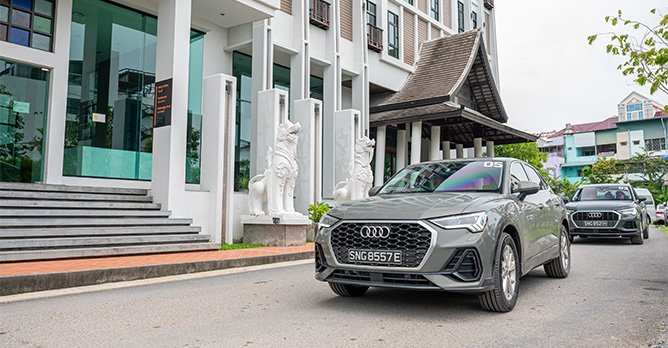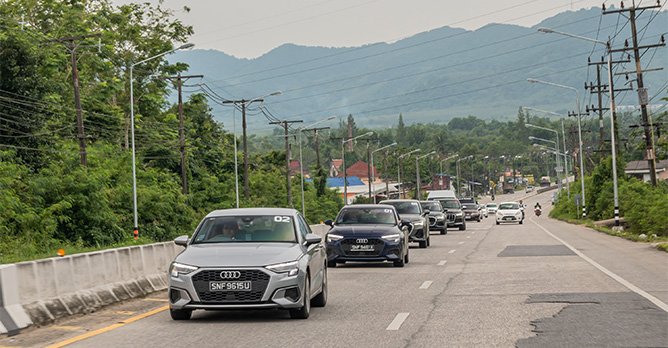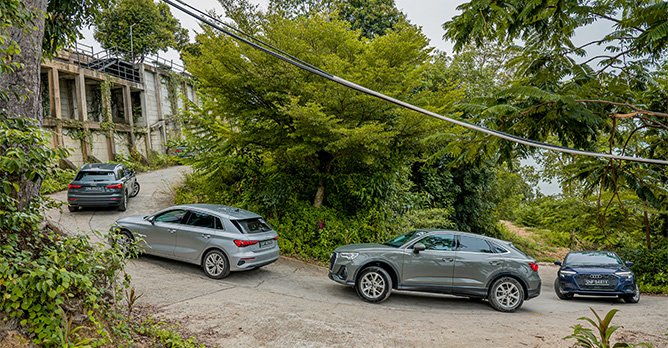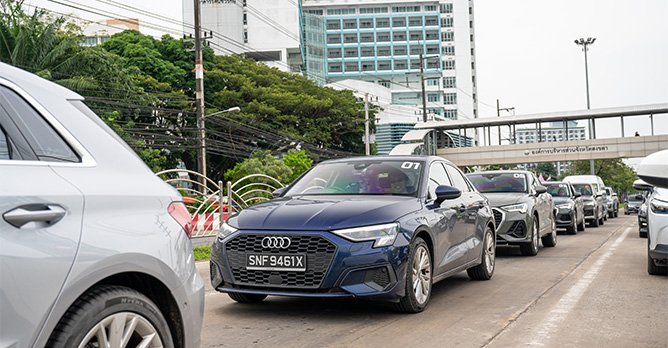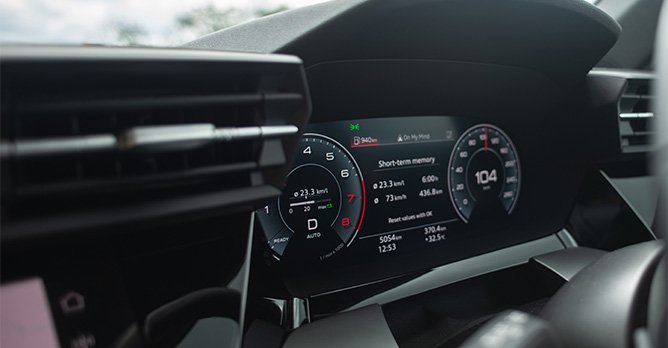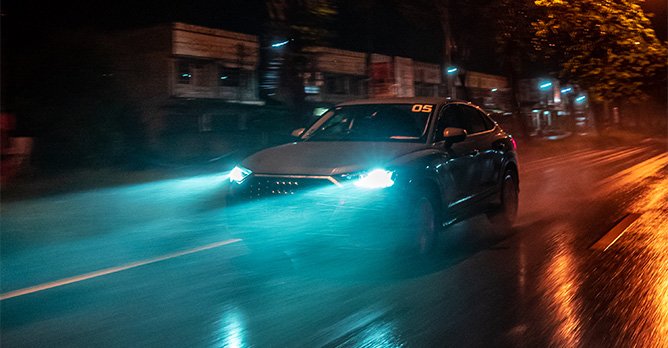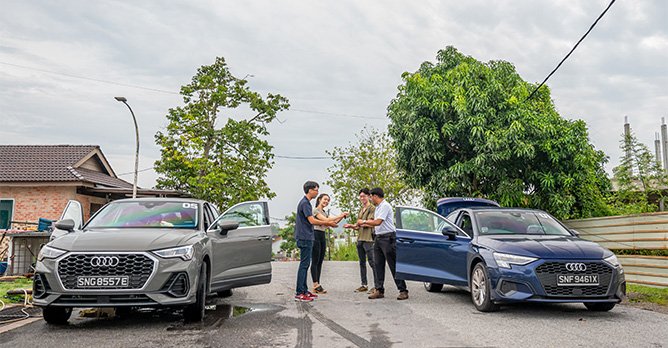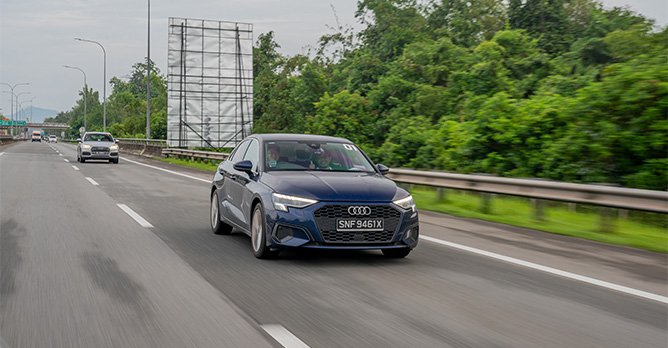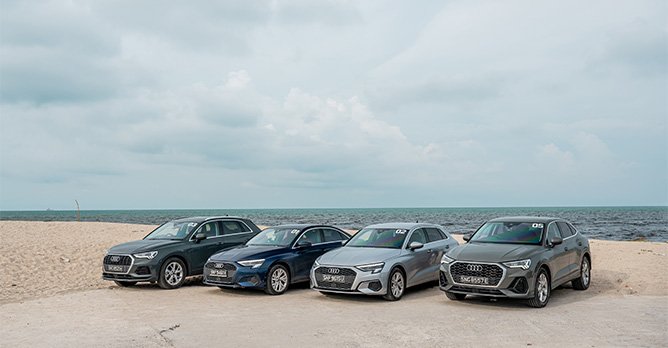Downsizing doesn't mean downgrading: Three days and 1,800km of combined driving in Audi's Q3 Sportback 1.5 and A3 Sedan 1.0
09 Nov 2022|4,992 views
It seems the Q3 Sportback's front sport seats, with their four-way lumbar support, have worked their magic.
Having spent more than 12 hours seated in them the day before, I've braced myself for some form of a backache the morning after, despite feeling fine after getting off the car. (Confounding as this may sound to older folks, one is legitimately not shielded from issues like that anymore in their late twenties.)
But apart from the residual fatigue of the drive, there is nothing of concern when I wake. In fact, in stumbling out of a deep slumber, I briefly forget that I am in the Southern Thai city of Hat Yai after a 900km vertical traverse of western Malaysia.
Downsizing has occurred a fair bit with Audi's compact range recently (at least on our shores), and we've taken on a fuel efficiency challenge with these new, smaller (and cleaner)-engined variants. After driving up to Thailand in the Q3 Sportback on day one, we will hop into the A3 Sedan instead for our journey back down, with our total fuel consumption calculated across both trips, then stacked against the other three teams.

 Note the absence of the 'quattro' badge on the grille: The 1.5-litre Q3s are purely front-wheel driven Previously powered by a 2.0-litre engine, the latest scoop includes the reintroduction of the Q3 and Q3 Sportback with mild hybrid assisted 1.5-litre engines. (The A3 Sedan and Sportback - previously offered in exactly that set-up - received 1.0-litre inline-threes just a few months back.)
Note the absence of the 'quattro' badge on the grille: The 1.5-litre Q3s are purely front-wheel driven Previously powered by a 2.0-litre engine, the latest scoop includes the reintroduction of the Q3 and Q3 Sportback with mild hybrid assisted 1.5-litre engines. (The A3 Sedan and Sportback - previously offered in exactly that set-up - received 1.0-litre inline-threes just a few months back.)
Both model pairings lose 40bhp with their smaller engines (fine, 39bhp for the A3s), but other squint-or-you'll-miss-them differences exist.
On the 1.5-litre Q3/Q3 Sportback, Audi's signature quattro badges disappear; they're only front-wheel driven.
The 1.0-litre A3s, on the other hand, get torsion-beam rather than multi-link rear suspension. Gone as well is the dedicated 'Efficiency' drive mode (although that's not really necessary; the twins are arguably in this mode permanently).
As we have been so conditioned, one can be forgiven for thinking they have to draw the shorter end of the stick by choosing the 'entry-level' variant.
But our experience with the cars across three days and 1,800km shows this isn't true. Driving up to, around, and then down from Thailand doesn't just allow us to stretch their fuel-sipping abilities. It also allows us to experience them in ways one typically wouldn't when cooped up in Singapore.
An extended test drive
Day two of the trip sees a few of us taking the cars out altogether for some light adventure-seeking, out of central Hat Yai and into Song Khla. I hop into the Q3 Sportback again, but with the efficiency challenge put on pause for the day, the entire compact family mostly sticks together.
In between stuffing ourselves with Thai iced tea and seafood, our routes involve the occasional tackling of some poorly-paved roads, getting fed up with one too many 90-second countdowns at some red lights, and crawling up and down the steep inclines of a hill/mini-mountain on Ko Yo Island.
Where stability was previously in higher demand on the never-ending NS Highway, today, manoeuvrability and light-footedness are favoured. Unsurprisingly, the Q3 Sportback thrives just as well in denser traffic conditions. Its steering is light, its size manageable, and its suspension set-up - exactly the same as that on the 2.0-litre variant - provides commendable cushioning from undulations underneath.
On this note of comfort, whatever one finds inside the more powerful variants of the Q3/Q3 Sportback and A3 Sedan/Sportback, one will also find in the less powerful ones. That means that those lumbar-supported seats - and the general function-forward, premium ethos espoused by Ingolstadt - remain. Meanwhile, screens don't shrink, and features (largely) don't disappear.
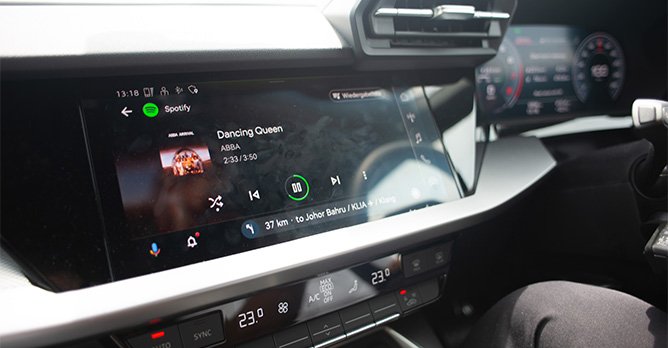
 Infotainment touchscreen (excuse the fingerprints) doesn't shrink in the 'entry-level' variants. Good Audis generally play the long game - less by dazzling you with technicolour shows or Hyperscreens, and more by winning you over firmly with their muted sensibility.
Infotainment touchscreen (excuse the fingerprints) doesn't shrink in the 'entry-level' variants. Good Audis generally play the long game - less by dazzling you with technicolour shows or Hyperscreens, and more by winning you over firmly with their muted sensibility.
The A3s get a slightly fresher dash as newer offerings, but they are similar to the Q3s up front. Unlike many competitors today, a plethora of properly-labelled physical buttons are thankfully still present beneath the vibrant 10.1-inch MMI infotainment touchscreen (which dispels excessive menu diving). They're there too, on the cars' flat-bottomed steering wheels.
There is no wondering what to press (not touch, thankfully) to arrive at where you want. Audi's 12.3-inch 'virtual cockpit plus', which can be toggled across different screens for navigation and media, also presents information to the driver without ambiguity.
In particular, our experiences bring to the fore situations where higher levels of concentration are required - driving on foreign roads, and being at the wheel for four to five hours at a stretch. In them, the virtues of an intuitive and driver-centric dash are made most apparent.
With minimal brainpower (or frustration; they're two sides of the same coin when in extreme fatigue), turning up the temperature because it's just started raining or skipping to a more upbeat track to keep yourself alert is done with complete ease.
About that power drop?
To return to the power difference, the cars rarely feel out of puff even though we are mostly well below the speed limit throughout our journey.
Even with their smaller engines, peak torque is reached relatively quickly, and gear-shifts are quick by way of the same seven-speed transmission. Neither the NS Highway nor the steep inclines of Ko Yo island strains the cars too drastically (for the latter, descending in the Q3s is made even more reassuring with Hill Descent Control offered as standard).
At one point, we even, as they say, give the cars the beans prior to starting the challenge for the Thailand-Singapore leg. They oblige - more than willingly.
But particular praise is due to the 1.0-litre unit of the A3 Sedan we drove on the way back, despite its seemingly low power output.
Before we proceed, we'll add the caveat: Manage your expectations, for the car takes 10.6 seconds to hit 100km/h from standstill. Back in Hat Yai, closing the gaps when convoying (sometimes very hurriedly) from point to point notably demanded more out of the car.
Once you're up to speed, however, the picture is quite rosy. The return leg of our fuel efficiency challenge came with the added dimension of a cut-off time to meet. On the NS Highway, pushing the Sedan up to its peak torque band between 2,000rpm and 3,000rpm in order to slip (sparingly) onto the fast lane didn't feel like a tall order, since it already finds itself between 1,750 to 2,000rpm when cruising along at 90km/h.
Above all, the driving experience is augmented by the car's remarkable level of refinement. Your ears will not be ringing with the roar of tyre and wind noise after a 12-hour journey, for the A3 Sedan - and the Q3 Sportback, for that matter - are capable long distance cruisers with well-insulated cabins.
Worth noting too is that it's hard to find fault with the A3 Sedan's ride comfort and handling, despite the supposed inferiority of its torsion beam rear suspension. In fact, its lower centre of gravity gives it better composure out on the highway than the Q3 Sportback (being built atop of the latest iteration of Volkswagen Group's MQB platform likely also helps).
Paring back: In the context of Singapore's roads
Singapore's roads always feel like they are moving in slow motion after a road trip up North. Where the A3 Sedan 1.0 has felt perfectly at home cutting through Malaysia, it is more than adequate on the PIE, supplanting road hogs on Lane 1 with confidence as we bear down towards the end point of our three-day trip.
Despite some heavy rain, and being forced into heavier-footedness for the drive back down, we've still managed a consumption of 23.1km/L when we officially end the trip at a petrol station along Moulmein Road. Across more than 800km, the A3 Sedan has used less than 36 litres of petrol (a full tank stands at 45 litres).
It's hard to imagine the average Singaporean driver taking the cars where we have across the three days - not just geographically, but in terms of pushing their limits in speed and efficiency. Nonetheless, these experiences have evinced the wide breadth of their capabilities.
While there's no mistaking that there's nothing 'entry-level' about even the most financially accessible of Audis (in other words, the cars you're looking at here), there's also no denying that they work very hard for their premium tag. All things considered, we say: They've definitely earned it.
Be sure to check out the first part of our Singapore-Hat Yai-Singapore road trip here if you haven't!
And here are some other articles that may interest you!
Audi's little compact has something for everyone, even the slightly unhinged
Forget the NSHW, East Coast Malaysia is where driving fun lies
Audi on the road to its environmental goals
A Superb road trip through Scotland
Having spent more than 12 hours seated in them the day before, I've braced myself for some form of a backache the morning after, despite feeling fine after getting off the car. (Confounding as this may sound to older folks, one is legitimately not shielded from issues like that anymore in their late twenties.)
But apart from the residual fatigue of the drive, there is nothing of concern when I wake. In fact, in stumbling out of a deep slumber, I briefly forget that I am in the Southern Thai city of Hat Yai after a 900km vertical traverse of western Malaysia.
Downsizing has occurred a fair bit with Audi's compact range recently (at least on our shores), and we've taken on a fuel efficiency challenge with these new, smaller (and cleaner)-engined variants. After driving up to Thailand in the Q3 Sportback on day one, we will hop into the A3 Sedan instead for our journey back down, with our total fuel consumption calculated across both trips, then stacked against the other three teams.

Both model pairings lose 40bhp with their smaller engines (fine, 39bhp for the A3s), but other squint-or-you'll-miss-them differences exist.
On the 1.5-litre Q3/Q3 Sportback, Audi's signature quattro badges disappear; they're only front-wheel driven.
The 1.0-litre A3s, on the other hand, get torsion-beam rather than multi-link rear suspension. Gone as well is the dedicated 'Efficiency' drive mode (although that's not really necessary; the twins are arguably in this mode permanently).
As we have been so conditioned, one can be forgiven for thinking they have to draw the shorter end of the stick by choosing the 'entry-level' variant.
But our experience with the cars across three days and 1,800km shows this isn't true. Driving up to, around, and then down from Thailand doesn't just allow us to stretch their fuel-sipping abilities. It also allows us to experience them in ways one typically wouldn't when cooped up in Singapore.
An extended test drive
Day two of the trip sees a few of us taking the cars out altogether for some light adventure-seeking, out of central Hat Yai and into Song Khla. I hop into the Q3 Sportback again, but with the efficiency challenge put on pause for the day, the entire compact family mostly sticks together.
In between stuffing ourselves with Thai iced tea and seafood, our routes involve the occasional tackling of some poorly-paved roads, getting fed up with one too many 90-second countdowns at some red lights, and crawling up and down the steep inclines of a hill/mini-mountain on Ko Yo Island.
Where stability was previously in higher demand on the never-ending NS Highway, today, manoeuvrability and light-footedness are favoured. Unsurprisingly, the Q3 Sportback thrives just as well in denser traffic conditions. Its steering is light, its size manageable, and its suspension set-up - exactly the same as that on the 2.0-litre variant - provides commendable cushioning from undulations underneath.
On this note of comfort, whatever one finds inside the more powerful variants of the Q3/Q3 Sportback and A3 Sedan/Sportback, one will also find in the less powerful ones. That means that those lumbar-supported seats - and the general function-forward, premium ethos espoused by Ingolstadt - remain. Meanwhile, screens don't shrink, and features (largely) don't disappear.

The A3s get a slightly fresher dash as newer offerings, but they are similar to the Q3s up front. Unlike many competitors today, a plethora of properly-labelled physical buttons are thankfully still present beneath the vibrant 10.1-inch MMI infotainment touchscreen (which dispels excessive menu diving). They're there too, on the cars' flat-bottomed steering wheels.
There is no wondering what to press (not touch, thankfully) to arrive at where you want. Audi's 12.3-inch 'virtual cockpit plus', which can be toggled across different screens for navigation and media, also presents information to the driver without ambiguity.
In particular, our experiences bring to the fore situations where higher levels of concentration are required - driving on foreign roads, and being at the wheel for four to five hours at a stretch. In them, the virtues of an intuitive and driver-centric dash are made most apparent.
With minimal brainpower (or frustration; they're two sides of the same coin when in extreme fatigue), turning up the temperature because it's just started raining or skipping to a more upbeat track to keep yourself alert is done with complete ease.
About that power drop?
To return to the power difference, the cars rarely feel out of puff even though we are mostly well below the speed limit throughout our journey.
Even with their smaller engines, peak torque is reached relatively quickly, and gear-shifts are quick by way of the same seven-speed transmission. Neither the NS Highway nor the steep inclines of Ko Yo island strains the cars too drastically (for the latter, descending in the Q3s is made even more reassuring with Hill Descent Control offered as standard).
At one point, we even, as they say, give the cars the beans prior to starting the challenge for the Thailand-Singapore leg. They oblige - more than willingly.
But particular praise is due to the 1.0-litre unit of the A3 Sedan we drove on the way back, despite its seemingly low power output.
Before we proceed, we'll add the caveat: Manage your expectations, for the car takes 10.6 seconds to hit 100km/h from standstill. Back in Hat Yai, closing the gaps when convoying (sometimes very hurriedly) from point to point notably demanded more out of the car.
Once you're up to speed, however, the picture is quite rosy. The return leg of our fuel efficiency challenge came with the added dimension of a cut-off time to meet. On the NS Highway, pushing the Sedan up to its peak torque band between 2,000rpm and 3,000rpm in order to slip (sparingly) onto the fast lane didn't feel like a tall order, since it already finds itself between 1,750 to 2,000rpm when cruising along at 90km/h.
Above all, the driving experience is augmented by the car's remarkable level of refinement. Your ears will not be ringing with the roar of tyre and wind noise after a 12-hour journey, for the A3 Sedan - and the Q3 Sportback, for that matter - are capable long distance cruisers with well-insulated cabins.
Worth noting too is that it's hard to find fault with the A3 Sedan's ride comfort and handling, despite the supposed inferiority of its torsion beam rear suspension. In fact, its lower centre of gravity gives it better composure out on the highway than the Q3 Sportback (being built atop of the latest iteration of Volkswagen Group's MQB platform likely also helps).
Paring back: In the context of Singapore's roads
Singapore's roads always feel like they are moving in slow motion after a road trip up North. Where the A3 Sedan 1.0 has felt perfectly at home cutting through Malaysia, it is more than adequate on the PIE, supplanting road hogs on Lane 1 with confidence as we bear down towards the end point of our three-day trip.
Despite some heavy rain, and being forced into heavier-footedness for the drive back down, we've still managed a consumption of 23.1km/L when we officially end the trip at a petrol station along Moulmein Road. Across more than 800km, the A3 Sedan has used less than 36 litres of petrol (a full tank stands at 45 litres).
It's hard to imagine the average Singaporean driver taking the cars where we have across the three days - not just geographically, but in terms of pushing their limits in speed and efficiency. Nonetheless, these experiences have evinced the wide breadth of their capabilities.
While there's no mistaking that there's nothing 'entry-level' about even the most financially accessible of Audis (in other words, the cars you're looking at here), there's also no denying that they work very hard for their premium tag. All things considered, we say: They've definitely earned it.
Be sure to check out the first part of our Singapore-Hat Yai-Singapore road trip here if you haven't!
And here are some other articles that may interest you!
Audi's little compact has something for everyone, even the slightly unhinged
Forget the NSHW, East Coast Malaysia is where driving fun lies
Audi on the road to its environmental goals
A Superb road trip through Scotland
It seems the Q3 Sportback's front sport seats, with their four-way lumbar support, have worked their magic.
Having spent more than 12 hours seated in them the day before, I've braced myself for some form of a backache the morning after, despite feeling fine after getting off the car. (Confounding as this may sound to older folks, one is legitimately not shielded from issues like that anymore in their late twenties.)
But apart from the residual fatigue of the drive, there is nothing of concern when I wake. In fact, in stumbling out of a deep slumber, I briefly forget that I am in the Southern Thai city of Hat Yai after a 900km vertical traverse of western Malaysia.
Downsizing has occurred a fair bit with Audi's compact range recently (at least on our shores), and we've taken on a fuel efficiency challenge with these new, smaller (and cleaner)-engined variants. After driving up to Thailand in the Q3 Sportback on day one, we will hop into the A3 Sedan instead for our journey back down, with our total fuel consumption calculated across both trips, then stacked against the other three teams.

 Note the absence of the 'quattro' badge on the grille: The 1.5-litre Q3s are purely front-wheel driven Previously powered by a 2.0-litre engine, the latest scoop includes the reintroduction of the Q3 and Q3 Sportback with mild hybrid assisted 1.5-litre engines. (The A3 Sedan and Sportback - previously offered in exactly that set-up - received 1.0-litre inline-threes just a few months back.)
Note the absence of the 'quattro' badge on the grille: The 1.5-litre Q3s are purely front-wheel driven Previously powered by a 2.0-litre engine, the latest scoop includes the reintroduction of the Q3 and Q3 Sportback with mild hybrid assisted 1.5-litre engines. (The A3 Sedan and Sportback - previously offered in exactly that set-up - received 1.0-litre inline-threes just a few months back.)
Both model pairings lose 40bhp with their smaller engines (fine, 39bhp for the A3s), but other squint-or-you'll-miss-them differences exist.
On the 1.5-litre Q3/Q3 Sportback, Audi's signature quattro badges disappear; they're only front-wheel driven.
The 1.0-litre A3s, on the other hand, get torsion-beam rather than multi-link rear suspension. Gone as well is the dedicated 'Efficiency' drive mode (although that's not really necessary; the twins are arguably in this mode permanently).
As we have been so conditioned, one can be forgiven for thinking they have to draw the shorter end of the stick by choosing the 'entry-level' variant.
But our experience with the cars across three days and 1,800km shows this isn't true. Driving up to, around, and then down from Thailand doesn't just allow us to stretch their fuel-sipping abilities. It also allows us to experience them in ways one typically wouldn't when cooped up in Singapore.
An extended test drive
Day two of the trip sees a few of us taking the cars out altogether for some light adventure-seeking, out of central Hat Yai and into Song Khla. I hop into the Q3 Sportback again, but with the efficiency challenge put on pause for the day, the entire compact family mostly sticks together.
In between stuffing ourselves with Thai iced tea and seafood, our routes involve the occasional tackling of some poorly-paved roads, getting fed up with one too many 90-second countdowns at some red lights, and crawling up and down the steep inclines of a hill/mini-mountain on Ko Yo Island.
Where stability was previously in higher demand on the never-ending NS Highway, today, manoeuvrability and light-footedness are favoured. Unsurprisingly, the Q3 Sportback thrives just as well in denser traffic conditions. Its steering is light, its size manageable, and its suspension set-up - exactly the same as that on the 2.0-litre variant - provides commendable cushioning from undulations underneath.
On this note of comfort, whatever one finds inside the more powerful variants of the Q3/Q3 Sportback and A3 Sedan/Sportback, one will also find in the less powerful ones. That means that those lumbar-supported seats - and the general function-forward, premium ethos espoused by Ingolstadt - remain. Meanwhile, screens don't shrink, and features (largely) don't disappear.

 Infotainment touchscreen (excuse the fingerprints) doesn't shrink in the 'entry-level' variants. Good Audis generally play the long game - less by dazzling you with technicolour shows or Hyperscreens, and more by winning you over firmly with their muted sensibility.
Infotainment touchscreen (excuse the fingerprints) doesn't shrink in the 'entry-level' variants. Good Audis generally play the long game - less by dazzling you with technicolour shows or Hyperscreens, and more by winning you over firmly with their muted sensibility.
The A3s get a slightly fresher dash as newer offerings, but they are similar to the Q3s up front. Unlike many competitors today, a plethora of properly-labelled physical buttons are thankfully still present beneath the vibrant 10.1-inch MMI infotainment touchscreen (which dispels excessive menu diving). They're there too, on the cars' flat-bottomed steering wheels.
There is no wondering what to press (not touch, thankfully) to arrive at where you want. Audi's 12.3-inch 'virtual cockpit plus', which can be toggled across different screens for navigation and media, also presents information to the driver without ambiguity.
In particular, our experiences bring to the fore situations where higher levels of concentration are required - driving on foreign roads, and being at the wheel for four to five hours at a stretch. In them, the virtues of an intuitive and driver-centric dash are made most apparent.
With minimal brainpower (or frustration; they're two sides of the same coin when in extreme fatigue), turning up the temperature because it's just started raining or skipping to a more upbeat track to keep yourself alert is done with complete ease.
About that power drop?
To return to the power difference, the cars rarely feel out of puff even though we are mostly well below the speed limit throughout our journey.
Even with their smaller engines, peak torque is reached relatively quickly, and gear-shifts are quick by way of the same seven-speed transmission. Neither the NS Highway nor the steep inclines of Ko Yo island strains the cars too drastically (for the latter, descending in the Q3s is made even more reassuring with Hill Descent Control offered as standard).
At one point, we even, as they say, give the cars the beans prior to starting the challenge for the Thailand-Singapore leg. They oblige - more than willingly.
But particular praise is due to the 1.0-litre unit of the A3 Sedan we drove on the way back, despite its seemingly low power output.
Before we proceed, we'll add the caveat: Manage your expectations, for the car takes 10.6 seconds to hit 100km/h from standstill. Back in Hat Yai, closing the gaps when convoying (sometimes very hurriedly) from point to point notably demanded more out of the car.
Once you're up to speed, however, the picture is quite rosy. The return leg of our fuel efficiency challenge came with the added dimension of a cut-off time to meet. On the NS Highway, pushing the Sedan up to its peak torque band between 2,000rpm and 3,000rpm in order to slip (sparingly) onto the fast lane didn't feel like a tall order, since it already finds itself between 1,750 to 2,000rpm when cruising along at 90km/h.
Above all, the driving experience is augmented by the car's remarkable level of refinement. Your ears will not be ringing with the roar of tyre and wind noise after a 12-hour journey, for the A3 Sedan - and the Q3 Sportback, for that matter - are capable long distance cruisers with well-insulated cabins.
Worth noting too is that it's hard to find fault with the A3 Sedan's ride comfort and handling, despite the supposed inferiority of its torsion beam rear suspension. In fact, its lower centre of gravity gives it better composure out on the highway than the Q3 Sportback (being built atop of the latest iteration of Volkswagen Group's MQB platform likely also helps).
Paring back: In the context of Singapore's roads
Singapore's roads always feel like they are moving in slow motion after a road trip up North. Where the A3 Sedan 1.0 has felt perfectly at home cutting through Malaysia, it is more than adequate on the PIE, supplanting road hogs on Lane 1 with confidence as we bear down towards the end point of our three-day trip.
Despite some heavy rain, and being forced into heavier-footedness for the drive back down, we've still managed a consumption of 23.1km/L when we officially end the trip at a petrol station along Moulmein Road. Across more than 800km, the A3 Sedan has used less than 36 litres of petrol (a full tank stands at 45 litres).
It's hard to imagine the average Singaporean driver taking the cars where we have across the three days - not just geographically, but in terms of pushing their limits in speed and efficiency. Nonetheless, these experiences have evinced the wide breadth of their capabilities.
While there's no mistaking that there's nothing 'entry-level' about even the most financially accessible of Audis (in other words, the cars you're looking at here), there's also no denying that they work very hard for their premium tag. All things considered, we say: They've definitely earned it.
Be sure to check out the first part of our Singapore-Hat Yai-Singapore road trip here if you haven't!
And here are some other articles that may interest you!
Audi's little compact has something for everyone, even the slightly unhinged
Forget the NSHW, East Coast Malaysia is where driving fun lies
Audi on the road to its environmental goals
A Superb road trip through Scotland
Having spent more than 12 hours seated in them the day before, I've braced myself for some form of a backache the morning after, despite feeling fine after getting off the car. (Confounding as this may sound to older folks, one is legitimately not shielded from issues like that anymore in their late twenties.)
But apart from the residual fatigue of the drive, there is nothing of concern when I wake. In fact, in stumbling out of a deep slumber, I briefly forget that I am in the Southern Thai city of Hat Yai after a 900km vertical traverse of western Malaysia.
Downsizing has occurred a fair bit with Audi's compact range recently (at least on our shores), and we've taken on a fuel efficiency challenge with these new, smaller (and cleaner)-engined variants. After driving up to Thailand in the Q3 Sportback on day one, we will hop into the A3 Sedan instead for our journey back down, with our total fuel consumption calculated across both trips, then stacked against the other three teams.

Both model pairings lose 40bhp with their smaller engines (fine, 39bhp for the A3s), but other squint-or-you'll-miss-them differences exist.
On the 1.5-litre Q3/Q3 Sportback, Audi's signature quattro badges disappear; they're only front-wheel driven.
The 1.0-litre A3s, on the other hand, get torsion-beam rather than multi-link rear suspension. Gone as well is the dedicated 'Efficiency' drive mode (although that's not really necessary; the twins are arguably in this mode permanently).
As we have been so conditioned, one can be forgiven for thinking they have to draw the shorter end of the stick by choosing the 'entry-level' variant.
But our experience with the cars across three days and 1,800km shows this isn't true. Driving up to, around, and then down from Thailand doesn't just allow us to stretch their fuel-sipping abilities. It also allows us to experience them in ways one typically wouldn't when cooped up in Singapore.
An extended test drive
Day two of the trip sees a few of us taking the cars out altogether for some light adventure-seeking, out of central Hat Yai and into Song Khla. I hop into the Q3 Sportback again, but with the efficiency challenge put on pause for the day, the entire compact family mostly sticks together.
In between stuffing ourselves with Thai iced tea and seafood, our routes involve the occasional tackling of some poorly-paved roads, getting fed up with one too many 90-second countdowns at some red lights, and crawling up and down the steep inclines of a hill/mini-mountain on Ko Yo Island.
Where stability was previously in higher demand on the never-ending NS Highway, today, manoeuvrability and light-footedness are favoured. Unsurprisingly, the Q3 Sportback thrives just as well in denser traffic conditions. Its steering is light, its size manageable, and its suspension set-up - exactly the same as that on the 2.0-litre variant - provides commendable cushioning from undulations underneath.
On this note of comfort, whatever one finds inside the more powerful variants of the Q3/Q3 Sportback and A3 Sedan/Sportback, one will also find in the less powerful ones. That means that those lumbar-supported seats - and the general function-forward, premium ethos espoused by Ingolstadt - remain. Meanwhile, screens don't shrink, and features (largely) don't disappear.

The A3s get a slightly fresher dash as newer offerings, but they are similar to the Q3s up front. Unlike many competitors today, a plethora of properly-labelled physical buttons are thankfully still present beneath the vibrant 10.1-inch MMI infotainment touchscreen (which dispels excessive menu diving). They're there too, on the cars' flat-bottomed steering wheels.
There is no wondering what to press (not touch, thankfully) to arrive at where you want. Audi's 12.3-inch 'virtual cockpit plus', which can be toggled across different screens for navigation and media, also presents information to the driver without ambiguity.
In particular, our experiences bring to the fore situations where higher levels of concentration are required - driving on foreign roads, and being at the wheel for four to five hours at a stretch. In them, the virtues of an intuitive and driver-centric dash are made most apparent.
With minimal brainpower (or frustration; they're two sides of the same coin when in extreme fatigue), turning up the temperature because it's just started raining or skipping to a more upbeat track to keep yourself alert is done with complete ease.
About that power drop?
To return to the power difference, the cars rarely feel out of puff even though we are mostly well below the speed limit throughout our journey.
Even with their smaller engines, peak torque is reached relatively quickly, and gear-shifts are quick by way of the same seven-speed transmission. Neither the NS Highway nor the steep inclines of Ko Yo island strains the cars too drastically (for the latter, descending in the Q3s is made even more reassuring with Hill Descent Control offered as standard).
At one point, we even, as they say, give the cars the beans prior to starting the challenge for the Thailand-Singapore leg. They oblige - more than willingly.
But particular praise is due to the 1.0-litre unit of the A3 Sedan we drove on the way back, despite its seemingly low power output.
Before we proceed, we'll add the caveat: Manage your expectations, for the car takes 10.6 seconds to hit 100km/h from standstill. Back in Hat Yai, closing the gaps when convoying (sometimes very hurriedly) from point to point notably demanded more out of the car.
Once you're up to speed, however, the picture is quite rosy. The return leg of our fuel efficiency challenge came with the added dimension of a cut-off time to meet. On the NS Highway, pushing the Sedan up to its peak torque band between 2,000rpm and 3,000rpm in order to slip (sparingly) onto the fast lane didn't feel like a tall order, since it already finds itself between 1,750 to 2,000rpm when cruising along at 90km/h.
Above all, the driving experience is augmented by the car's remarkable level of refinement. Your ears will not be ringing with the roar of tyre and wind noise after a 12-hour journey, for the A3 Sedan - and the Q3 Sportback, for that matter - are capable long distance cruisers with well-insulated cabins.
Worth noting too is that it's hard to find fault with the A3 Sedan's ride comfort and handling, despite the supposed inferiority of its torsion beam rear suspension. In fact, its lower centre of gravity gives it better composure out on the highway than the Q3 Sportback (being built atop of the latest iteration of Volkswagen Group's MQB platform likely also helps).
Paring back: In the context of Singapore's roads
Singapore's roads always feel like they are moving in slow motion after a road trip up North. Where the A3 Sedan 1.0 has felt perfectly at home cutting through Malaysia, it is more than adequate on the PIE, supplanting road hogs on Lane 1 with confidence as we bear down towards the end point of our three-day trip.
Despite some heavy rain, and being forced into heavier-footedness for the drive back down, we've still managed a consumption of 23.1km/L when we officially end the trip at a petrol station along Moulmein Road. Across more than 800km, the A3 Sedan has used less than 36 litres of petrol (a full tank stands at 45 litres).
It's hard to imagine the average Singaporean driver taking the cars where we have across the three days - not just geographically, but in terms of pushing their limits in speed and efficiency. Nonetheless, these experiences have evinced the wide breadth of their capabilities.
While there's no mistaking that there's nothing 'entry-level' about even the most financially accessible of Audis (in other words, the cars you're looking at here), there's also no denying that they work very hard for their premium tag. All things considered, we say: They've definitely earned it.
Be sure to check out the first part of our Singapore-Hat Yai-Singapore road trip here if you haven't!
And here are some other articles that may interest you!
Audi's little compact has something for everyone, even the slightly unhinged
Forget the NSHW, East Coast Malaysia is where driving fun lies
Audi on the road to its environmental goals
A Superb road trip through Scotland
Thank You For Your Subscription.









































